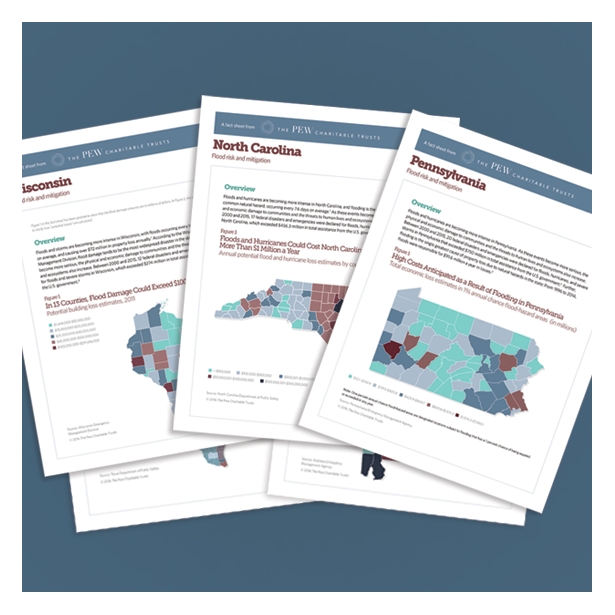Florida
Flood risk and mitigation
Overview
Floods and hurricanes are a serious threat to Florida, causing loss of life and considerable physical and economic damage to communities. Between 2000 and 2017, 25 federal disasters were declared for floods, hurricanes, and severe storms in the state. To counter the impact of severe weather, Florida is investing in measures such as elevating buildings and converting flood-prone areas into green spaces to better protect homes and businesses— and it’s realizing a large return on investment.1
Federal flood insurance helps communities prepare
In Florida, 238 localities participate in the National Flood Insurance Program’s Community Rating System.2 This voluntary program offers communities lower insurance premiums if they have flood plain management practices that exceed the program’s minimum requirements. These practices include buying out flood-prone homes, improving storm drainage, elevating buildings, and flood proofing structures. The city of Ocala has taken advantage of this program and earned a Community Rating System Class 3 designation, which has garnered Ocala policyholders living in a designated flood zone a 35 percent discount on flood insurance premiums.3
Flood resilience for buildings saves money
In the most flood-prone parts of Florida, building two feet above the code requirement returns $21.10 for every dollar invested.4
Importance of policy
Communities must take actions to better prepare for weather-related catastrophes such as floods. And federal officials should consider policy reforms that would improve flood protection and preparation, minimize disruptions to the economy, and reduce costs to the federal government and taxpayers. These actions include:
- Increasing federal investment in flood mitigation programs that help communities prepare for and reduce the damage from floods.
- Improving resiliency requirements for infrastructure built and rebuilt in flood-prone areas.
- Protecting ecosystems, such as wetlands, salt marshes, and dunes, that can act as barriers to storms and help shield property.
- Reforming the National Flood Insurance Program to better communicate actual risk, break the cycle of repeated loss and rebuilding in the most flood-prone areas, and provide incentives for communities and homeowners to better prepare for floods.
Endnotes
- Florida Division of Emergency Management, “Loss Avoidance Assessment” (2017), https://www.floridadisaster.org/globalassets/importedpdfs/01_dr-4283-loss-avoidance-report.pdf.
- Federal Emergency Management Agency, “Community Rating System” (2017), https://www.fema.gov/media-library-data/1503240360683-30b35cc754f462fe2c15d857519a71ec/20_crs_508_oct2017.pdf.
- Federal Emergency Management Agency, “Community Rating System” (2017), https://www.fema.gov/media-library-data/1507029324530-082938e6607d4d9eba4004890dbad39c/NFIP_CRS_Fact_Sheet_2017_508OK.pdf.
- National Institute of Building Sciences, “Natural Hazard Mitigation Saves: 2017 Interim Report” (2017), https://www.nibs.org/page/mitigationsaves. This finding refers to new buildings in coastal velocity zones, the most hazardous of the special flood hazard areas.













